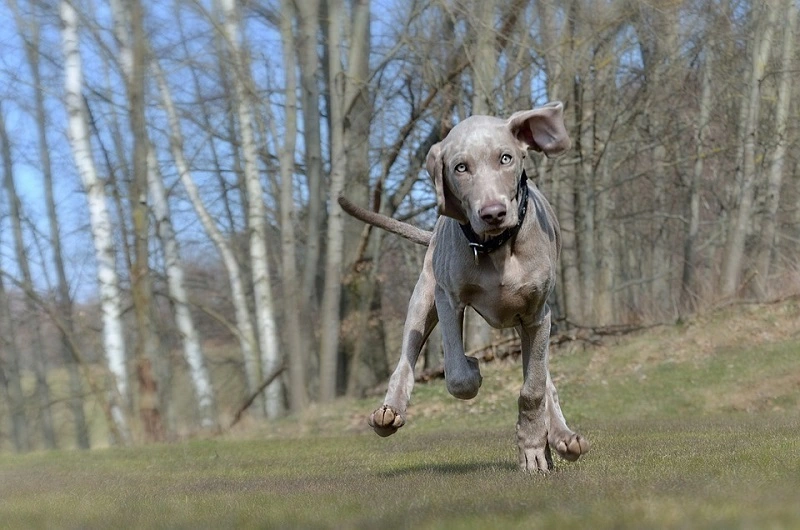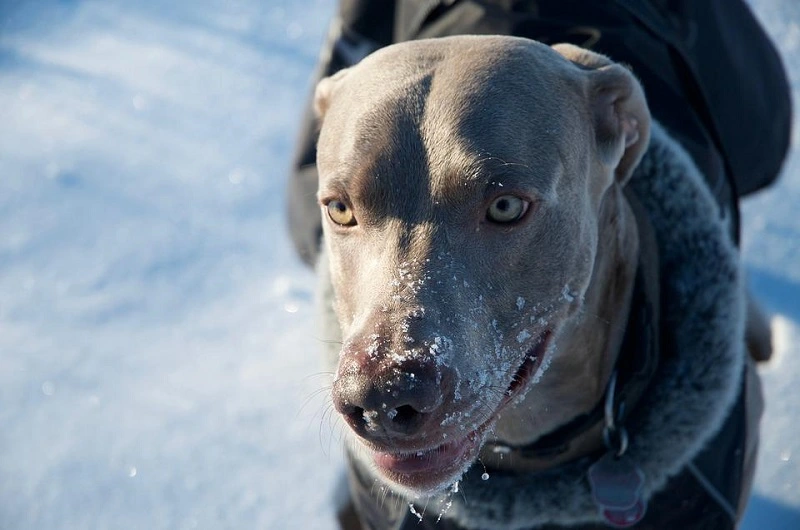Weimaraner Dog - Breed Description, Temperament, Puppies, Prices
The Weimaraner is a large dog. Not only it has a strong, mighty silhouette, but also a beautiful, unusual coat color. The breed used to serve as a hunting dog, so it's a perfect partner for someone active, who can give it enough attention. What should you know before picking a dog of this breed as your companion? How to take care of a Weimaraner dog? Check the most important information. It's essential to make sure the pet feels good at your place.

The Weimaraner - breed’s origins
There are many theories about the primary place of origin of dogs of this breed. But it has been officially accepted they come from Germany. Another common theory points to France as their primary region. According to it, the Weimaraner originates from grey dogs the French ruler used for hunting.
Until 1890, the Weimaraner was used in accordance with the breed’s purpose, which is hunting in forests. Official breeding of the dogs begun later, which also made them more popular. Interestingly enough, up to 1929, it was forbidden to breed them outside Germany.

What does the Weimaraner look like?
The Weimaraner is characteristic primarily for its size. Because of this, it needs appropriate conditions, so it doesn’t feel overwhelmed e.g., by too little space in an apartment. It needs enough space for its bed, to easily stretch its legs.
The Weimaraner’s body is quite robust. At the same time, the animal looks dignified - some refer to it as “aristocratic.” The dog’s neck is long, and the head has a distinct profile.
Interestingly enough, Weimaraner puppies are born with grey-blue eyes. As they grow up, the eye color gradually changes to amber.
The breed can also be categorized according to its coat’s length. In this case, there are two types of this dog:
- short-haired Weimaraner,
- Weimaraner with long hair, the fur is typically 3-5 cm (1.18-1.97 in) long.
Male dogs of this breed are usually from 59 to 70 cm (1.9-2.27 ft) tall at withers, and weigh from 30 to 40 kg (66.1-88.18 lb). Females are only slightly smaller. They are from 57 to 65 cm (1.87-2.13 ft) tall and weigh from 25 to 35 kg (55.12-77.16 lb).

The Weimaraner - temperament and behavior
Those who decide on a dog of this breed should remember that the Weimaraner has a strong hunting instinct (because of its historical background) and an incredibly sensitive sense of smell. The good news is that these animals are very loyal and well-balanced. They aren’t stubborn dogs, but their strong personality requires some skill to control it.
The Weimaraner is a highly intelligent and eager to learn. The animal needs a lot of attention, but also, despite its size, it loves playing and cuddling. Typically, these dogs don’t display any aggression, which makes them perfect pets for families with small children. The dog always has the strongest bond with one caregiver.
Is the Weimaraner a good dog for everyone?
The Weimaraner, despite its many advantages, is not a dog for everyone. It’s mostly because the breed needs a lot of attention. Being active, both physically and intellectually, is an essential element of its life. The minimum daily dose of physical activity is 1-2 hours. In practice, it means it’s not an ideal companion for people who are busy with their work. One has to find enough time for playing and walking with the dog, as well as taking care of its intellectual development. Some owners hire someone who will take care of the dog and participate in its daily activities. But this doesn’t mean that the dog’s owner is completely absolved from their duties. The caregiver should get involved in the dog’s development - despite other activities.

The Weimaraner - how to train the dog?
The Weimaraner is a relatively easy dog to train. But it requires assertiveness in all activities, which allows you to take full control over the dog. The Weimaraner dog usually isn’t problematic to train. Nonetheless, those who lack experience should use some assistance, e.g., during professional dog training classes.
Where to seek for experts who would help you train a dog of this breed? We suggest picking a place, or an individual professional who have prior experience with pointing breeds. You can find plenty of information on the Web, along with reviews from people who have used such services. Thanks to this, you can pick the best option.
Initially, the expert is directly involved in the training. They have to get to know the dog and evaluate its possibilities and character. The dog is taught certain behaviors and commands. Then, the owner is allowed to train with the dog under the expert’s supervision. One might also get some homework to do at home. Consequence is of the utmost importance, as it’s the key to the dog’s obedience.
The Weimaraner - the best diet for the dog
If you decided to take a Weimaraner dog home, the good news is that it doesn’t have any special feeding needs. Animals suffering from food allergies are the only exception, but it’s a rare condition. Just like other dogs, Weimaraner puppies require more frequent meals, so they can develop properly.
These dogs are real foodies, so make sure your adult dog eats 2, or maximum 3 meals per day. Don’t worry the dog will get malnourished. The animal can’t control its appetite, so it devours anything given to it. Note that Weimaraners have a tendency to gain weight quickly. For this reason, avoid overfeeding or giving them too calorific meals. These dogs cannot have unlimited access to food. Also, control the number of snacks the dog receives.

Weimaraner dogs - grooming
The Weimaraner is a breed that doesn’t require any special care. Just remember about regular brushing at least once per week. This way, you remove dead hair and encourage the fur to grow. A massage improves blood circulation, which positively affects the animal’s health and well-being.
Also, owners of these dogs have to control their ears and teeth, and clean them as needed. It’s very important to prevent infections. They are not only difficult to get rid of, but also tiresome for the dog. They cause pain and swelling, making the pet less cooperative.
Don’t bathe your Weimaraner too frequently. Do it only when necessary, and make sure you use an adequate shampoo for delicate dogs. Such products contain soothing substances and oils that take care of the dog’s fur and skin.
Remember that dogs of this breed don’t have underfur, which means they don’t take low temperatures well. Also, avoid strenuous activities during very hot days.
What are the most common diseases of Weimaraner dogs?
Because the Weimaraner is a large dog, it’s vulnerable to typical ailments such animals suffer from. Professionals often mention hip dysplasia. The comfort of living is decreased for animals suffering from it, which might also affect their personality and make them less eager to get involved in everyday activities.
Furthermore, the breed is particularly vulnerable to skin cancers. Make sure to check the animal’s skin, e.g., when cuddling with the dog. If you notice any palpable lumps, consult a specialist. They will determine what exactly the lesions are. Because of the tendency for skin issues, the animal shouldn’t get exposed to full sun for too long. It might cause skin burns, which could also cause various health problems.
The Weimaraner can suffer from hemophilia as well. The disease means that in case the dog gets injured during a walk, it will require special medications to stop the bleeding. Neglecting the problem is a threat to the dog’s life.

The Weimaraner - lifespan of the animal
The Weimaraner lives relatively long - in comparison with other dog breeds. Of course, everything depends on the living conditions and any diseases the dog suffers from. On average, these dogs live from 10 to 14 years. Of course, it’s not a fixed rule, so some dogs live much longer or shorter (as a result of health issues). Regular checkups at a veterinary clinic are crucial. Make sure to make an appointment at least twice a year.
The Weimaraner - puppies and their prices
If you want to buy a puppy of this breed, prepare to spend some money. A Weimaraner from a less reputable breeder costs around $800, which is quite affordable for a dog of this class. But some breeders sell puppies for much more. The price might oscillate around $1,200, or greatly exceed this limit. The breeder’s reputation is important. Professional facilities take care of the dogs’ health and make sure to check them carefully. Thanks to this, you can be sure the animal you get doesn’t have any hidden health issues that might emerge after several months or even years.

📍 What is the Weimaraner dog like?
The Weimaraner is a large dog. It can grow up to 70 cm (2.27 ft) at withers and weigh up to 40 kg (88.18 lb). It has short hair. The dog is considered a very balanced and easy to train animal.
📍 How long do Weimaraners live?
The Weimaraner is a long-living dog. Healthy animals live 11-14 years long on average. Of course, it's not a rule. The lifespan depends on factors such as the living conditions the dog is kept in.
📍 How much does a Weimaraner puppy cost?
The Weimaraner is not the most expensive dog breed. The price one has to pay for a puppy depends on the breeder and the pedigree of the dog. In relation to various factors, a dog might cost from $800 to over $1,500.
📍 What does the Weimaraner dog eat?
The Weimaraner dog is a breed of an insatiable appetite. It means the owner should strictly control what the animal eats. Make sure the meals are regular and diverse - the dog should eat both dry and wet food.
Featured articles
Maybe you're interested




